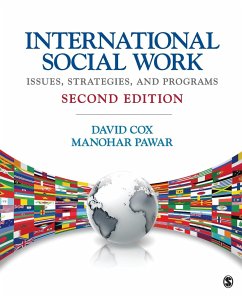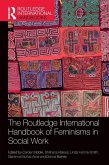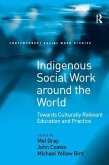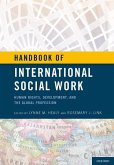- Broschiertes Buch
- Merkliste
- Auf die Merkliste
- Bewerten Bewerten
- Teilen
- Produkt teilen
- Produkterinnerung
- Produkterinnerung
Focusing on the experience of teaching and practicing international social work, rather than reflecting on the field, this book offers practical knowledge and strategies aimed at actively addressing issues that are critical to the well-being of people, communities, and nations around the world.
Andere Kunden interessierten sich auch für
![Social Work Practice With Older Adults Social Work Practice With Older Adults]() Jill M. ChonodySocial Work Practice With Older Adults123,99 €
Jill M. ChonodySocial Work Practice With Older Adults123,99 €![The Routledge International Handbook of Feminisms in Social Work The Routledge International Handbook of Feminisms in Social Work]() The Routledge International Handbook of Feminisms in Social Work296,99 €
The Routledge International Handbook of Feminisms in Social Work296,99 €![Indigenous Social Work around the World Indigenous Social Work around the World]() John CoatesIndigenous Social Work around the World207,99 €
John CoatesIndigenous Social Work around the World207,99 €![Responsive Leadership in Social Services Responsive Leadership in Social Services]() Stephen de GrootResponsive Leadership in Social Services100,99 €
Stephen de GrootResponsive Leadership in Social Services100,99 €![Critical Thinking in Health and Social Care Critical Thinking in Health and Social Care]() Stella Jones-DevittCritical Thinking in Health and Social Care66,99 €
Stella Jones-DevittCritical Thinking in Health and Social Care66,99 €![Making Sense of the Social World - International Student Edition Making Sense of the Social World - International Student Edition]() Daniel F. ChamblissMaking Sense of the Social World - International Student Edition103,99 €
Daniel F. ChamblissMaking Sense of the Social World - International Student Edition103,99 €![Handbook of International Social Work Handbook of International Social Work]() Handbook of International Social Work206,99 €
Handbook of International Social Work206,99 €-
-
-
Focusing on the experience of teaching and practicing international social work, rather than reflecting on the field, this book offers practical knowledge and strategies aimed at actively addressing issues that are critical to the well-being of people, communities, and nations around the world.
Hinweis: Dieser Artikel kann nur an eine deutsche Lieferadresse ausgeliefert werden.
Hinweis: Dieser Artikel kann nur an eine deutsche Lieferadresse ausgeliefert werden.
Produktdetails
- Produktdetails
- Verlag: SAGE Publications Inc
- 2 Revised edition
- Seitenzahl: 640
- Erscheinungstermin: 4. Dezember 2012
- Englisch
- Abmessung: 235mm x 191mm x 34mm
- Gewicht: 1192g
- ISBN-13: 9781452217482
- ISBN-10: 1452217483
- Artikelnr.: 36392578
- Herstellerkennzeichnung
- Libri GmbH
- Europaallee 1
- 36244 Bad Hersfeld
- gpsr@libri.de
- Verlag: SAGE Publications Inc
- 2 Revised edition
- Seitenzahl: 640
- Erscheinungstermin: 4. Dezember 2012
- Englisch
- Abmessung: 235mm x 191mm x 34mm
- Gewicht: 1192g
- ISBN-13: 9781452217482
- ISBN-10: 1452217483
- Artikelnr.: 36392578
- Herstellerkennzeichnung
- Libri GmbH
- Europaallee 1
- 36244 Bad Hersfeld
- gpsr@libri.de
After a distinguished career as a social work educator and administrator, Dr. Cox currently teaches as an adjunct lecturer at La Trobe University in Australia. His professional interests have included work in social work and immigration and the experiences of refugees. He has written scores of articles and several books. He was awarded his Ph. D. from La Trobe in 1974.
Introduction
Acknowledgments
1. International Social Work
Social Work
The Global Spread and Organization of Social Work
International Social Work
Conclusion
2. The Integrated-perspectives Approach to International Social Work
The Global Perspective
The Human Rights Perspective
The Ecological Perspective
The Social Development Perspective
The Integrated-perspectives Approach as a Whole
The Integrated-perspectives Approach and Existing Social Work Theories
The Application of the Integrated-perspectives Approach to International
Social Work
Conclusion
3. The Global Context of International Social Work
Introduction
The Global Social Problems Context
The Organizational Context
The Ideological Context
The Emerging Policy Context: The Emergence of Global Social and Economic
Policy and of International Law, and the Significance of These for
International Social Work Practice
Conclusion
4. Basic Programs and Strategies for International Social Work
Introduction
Empowerment
Capacity Building
Self-help and Self-reliance
Enhancing Social Integration or Social Cohesion
Income-generation
Community Development
Conclusion
5. The Field of Development: Background and Issues
Global Development Since 1945: The Various Paths to Development
Local-level Development
Conclusion
6. The Field of Development: Programs and Strategies
Local-level Development
Goals and Strategies Pertaining to Local-level Development
Key Strategies and Programs Appropriate to Local-level Development
The Place for Integrated Comprehensive Programs
Conclusion
7. The Field of Poverty: Background and Issues
Perspectives on Poverty: The Integrated-Perspectives Approach and Poverty
Global Poverty: Current Dimensions and Trends
Global Poverty: The Various Types or Facets of Poverty
Globalization and Poverty
The Poverty of the United Nations' List of Least Developed Countries
Globally Induced Poverty
Poverty and the Development Process
Subsistence Poverty
Rural Poverty
Urban Poverty
Poverty and Specific Population Categories
Consequential Poverty
Definitions and Forms of Poverty
Conclusion
8. The Field of Poverty: Programs and Strategies
Poverty Alleviation in Context
A Model of Poverty Alleviation for International Social Work
Poverty Alleviation Programs and Strategies Used in International Social
Work
Conclusion
9. The Field of Conflict and Post-conflict Reconstruction: Background and
Issues
The Integrated-perspectives Approach and Conflict and Peace Issues
The Extent and Nature of Modern Conflict
The Role of the United Nations
The Role of Global Civil Society
The Postconflict Response
The Postconflict Situation and the Postconflict Reconstruction Agenda
The Humanitarian Aid Debate
Conclusion
10. The Field of Conflict and Postconflict Reconstruction: Programs and
Strategies
Implementing the Comprehensive Postconflict Agenda
Some Key Areas of International Social Work in the Postconflict Situation
Delivering Psychosocial Programs
Rebuilding Communities
Securing and Maintaining Peace and Promoting Reconciliation
Conclusion
11. The Field of Migration and Labor Migration: Background and Issues
The Integrated Perspectives Approach to Migration
Global Migration
Labor Market Migration
Migrant Workers
Irregular Workers
Trafficked Persons
Conclusion
12. The Field of Displacement and Forced Migration: Background and Issues
Forced Migration: The Presenting Situation and Its Background
The Nature of Forced Migration in the Contemporary World
Forced Migration Movements and Numbers in Recent Times
A Critical Analysis of the Forced Migration Situation
Specific Aspects of International Social Work's Involvement in Forced
Migration Situations
Conclusion
13. The Field of Migration: Programs and Strategies
Labor Migration
Displacement and Forced Migration
A General Overview of Social Work Programs in Forced Migration Situations
Some Specific Programs and Strategies for Responding to Various Forced
Migration Situations
Humanitarian Aid and Its Distribution
Programs Humanizing Existing Conditions
Trauma Counseling Programs
Support Programs
Social and Recreational Programs
Children's Education and Psychosocial Programs
Services for Refugee Women
Family Reunion Programs
Repatriation Programs
Integration Programs
Human Rights Programs
Legal Programs
Community Development Programs
Conclusion
14. International Social Work With Specific Populations
Street Children
Child Laborers
Orphans and the HIV/AIDS Crisis
Child Soldiers
Youth in Developing Countries
Elderly Persons in Developing Countries
Persons with Disability in Developing Countries
Conclusion
15. International Organizations - Roles for Social Workers and Preparation
of Social Workers for International Social Work
International Organizations
Roles for Social Workers in International Organizations
Preparation of Social Workers for International Social Work Practice
Conclusion
16. Challenges for International Social Work for the Twenty-first Century
The Way Ahead for International Social Work: Where Should International
Social Work Be Heading in the Twenty-first Century?
Changes Required to Social Work Education
Changes Required to Social Work Practice
Careers in International Social Work: Social Work
Graduates' Response to International Social Work
The Global Organization of Social Work
Conclusion
Appendix A: International Federation of Social Workers (IFSW) International
Association of Schools of Social Work (IASSW)
Appendix B: Acronyms
Appendix C: Useful Websites
References
Index
About the Authors
Acknowledgments
1. International Social Work
Social Work
The Global Spread and Organization of Social Work
International Social Work
Conclusion
2. The Integrated-perspectives Approach to International Social Work
The Global Perspective
The Human Rights Perspective
The Ecological Perspective
The Social Development Perspective
The Integrated-perspectives Approach as a Whole
The Integrated-perspectives Approach and Existing Social Work Theories
The Application of the Integrated-perspectives Approach to International
Social Work
Conclusion
3. The Global Context of International Social Work
Introduction
The Global Social Problems Context
The Organizational Context
The Ideological Context
The Emerging Policy Context: The Emergence of Global Social and Economic
Policy and of International Law, and the Significance of These for
International Social Work Practice
Conclusion
4. Basic Programs and Strategies for International Social Work
Introduction
Empowerment
Capacity Building
Self-help and Self-reliance
Enhancing Social Integration or Social Cohesion
Income-generation
Community Development
Conclusion
5. The Field of Development: Background and Issues
Global Development Since 1945: The Various Paths to Development
Local-level Development
Conclusion
6. The Field of Development: Programs and Strategies
Local-level Development
Goals and Strategies Pertaining to Local-level Development
Key Strategies and Programs Appropriate to Local-level Development
The Place for Integrated Comprehensive Programs
Conclusion
7. The Field of Poverty: Background and Issues
Perspectives on Poverty: The Integrated-Perspectives Approach and Poverty
Global Poverty: Current Dimensions and Trends
Global Poverty: The Various Types or Facets of Poverty
Globalization and Poverty
The Poverty of the United Nations' List of Least Developed Countries
Globally Induced Poverty
Poverty and the Development Process
Subsistence Poverty
Rural Poverty
Urban Poverty
Poverty and Specific Population Categories
Consequential Poverty
Definitions and Forms of Poverty
Conclusion
8. The Field of Poverty: Programs and Strategies
Poverty Alleviation in Context
A Model of Poverty Alleviation for International Social Work
Poverty Alleviation Programs and Strategies Used in International Social
Work
Conclusion
9. The Field of Conflict and Post-conflict Reconstruction: Background and
Issues
The Integrated-perspectives Approach and Conflict and Peace Issues
The Extent and Nature of Modern Conflict
The Role of the United Nations
The Role of Global Civil Society
The Postconflict Response
The Postconflict Situation and the Postconflict Reconstruction Agenda
The Humanitarian Aid Debate
Conclusion
10. The Field of Conflict and Postconflict Reconstruction: Programs and
Strategies
Implementing the Comprehensive Postconflict Agenda
Some Key Areas of International Social Work in the Postconflict Situation
Delivering Psychosocial Programs
Rebuilding Communities
Securing and Maintaining Peace and Promoting Reconciliation
Conclusion
11. The Field of Migration and Labor Migration: Background and Issues
The Integrated Perspectives Approach to Migration
Global Migration
Labor Market Migration
Migrant Workers
Irregular Workers
Trafficked Persons
Conclusion
12. The Field of Displacement and Forced Migration: Background and Issues
Forced Migration: The Presenting Situation and Its Background
The Nature of Forced Migration in the Contemporary World
Forced Migration Movements and Numbers in Recent Times
A Critical Analysis of the Forced Migration Situation
Specific Aspects of International Social Work's Involvement in Forced
Migration Situations
Conclusion
13. The Field of Migration: Programs and Strategies
Labor Migration
Displacement and Forced Migration
A General Overview of Social Work Programs in Forced Migration Situations
Some Specific Programs and Strategies for Responding to Various Forced
Migration Situations
Humanitarian Aid and Its Distribution
Programs Humanizing Existing Conditions
Trauma Counseling Programs
Support Programs
Social and Recreational Programs
Children's Education and Psychosocial Programs
Services for Refugee Women
Family Reunion Programs
Repatriation Programs
Integration Programs
Human Rights Programs
Legal Programs
Community Development Programs
Conclusion
14. International Social Work With Specific Populations
Street Children
Child Laborers
Orphans and the HIV/AIDS Crisis
Child Soldiers
Youth in Developing Countries
Elderly Persons in Developing Countries
Persons with Disability in Developing Countries
Conclusion
15. International Organizations - Roles for Social Workers and Preparation
of Social Workers for International Social Work
International Organizations
Roles for Social Workers in International Organizations
Preparation of Social Workers for International Social Work Practice
Conclusion
16. Challenges for International Social Work for the Twenty-first Century
The Way Ahead for International Social Work: Where Should International
Social Work Be Heading in the Twenty-first Century?
Changes Required to Social Work Education
Changes Required to Social Work Practice
Careers in International Social Work: Social Work
Graduates' Response to International Social Work
The Global Organization of Social Work
Conclusion
Appendix A: International Federation of Social Workers (IFSW) International
Association of Schools of Social Work (IASSW)
Appendix B: Acronyms
Appendix C: Useful Websites
References
Index
About the Authors
Introduction
Acknowledgments
1. International Social Work
Social Work
The Global Spread and Organization of Social Work
International Social Work
Conclusion
2. The Integrated-perspectives Approach to International Social Work
The Global Perspective
The Human Rights Perspective
The Ecological Perspective
The Social Development Perspective
The Integrated-perspectives Approach as a Whole
The Integrated-perspectives Approach and Existing Social Work Theories
The Application of the Integrated-perspectives Approach to International
Social Work
Conclusion
3. The Global Context of International Social Work
Introduction
The Global Social Problems Context
The Organizational Context
The Ideological Context
The Emerging Policy Context: The Emergence of Global Social and Economic
Policy and of International Law, and the Significance of These for
International Social Work Practice
Conclusion
4. Basic Programs and Strategies for International Social Work
Introduction
Empowerment
Capacity Building
Self-help and Self-reliance
Enhancing Social Integration or Social Cohesion
Income-generation
Community Development
Conclusion
5. The Field of Development: Background and Issues
Global Development Since 1945: The Various Paths to Development
Local-level Development
Conclusion
6. The Field of Development: Programs and Strategies
Local-level Development
Goals and Strategies Pertaining to Local-level Development
Key Strategies and Programs Appropriate to Local-level Development
The Place for Integrated Comprehensive Programs
Conclusion
7. The Field of Poverty: Background and Issues
Perspectives on Poverty: The Integrated-Perspectives Approach and Poverty
Global Poverty: Current Dimensions and Trends
Global Poverty: The Various Types or Facets of Poverty
Globalization and Poverty
The Poverty of the United Nations' List of Least Developed Countries
Globally Induced Poverty
Poverty and the Development Process
Subsistence Poverty
Rural Poverty
Urban Poverty
Poverty and Specific Population Categories
Consequential Poverty
Definitions and Forms of Poverty
Conclusion
8. The Field of Poverty: Programs and Strategies
Poverty Alleviation in Context
A Model of Poverty Alleviation for International Social Work
Poverty Alleviation Programs and Strategies Used in International Social
Work
Conclusion
9. The Field of Conflict and Post-conflict Reconstruction: Background and
Issues
The Integrated-perspectives Approach and Conflict and Peace Issues
The Extent and Nature of Modern Conflict
The Role of the United Nations
The Role of Global Civil Society
The Postconflict Response
The Postconflict Situation and the Postconflict Reconstruction Agenda
The Humanitarian Aid Debate
Conclusion
10. The Field of Conflict and Postconflict Reconstruction: Programs and
Strategies
Implementing the Comprehensive Postconflict Agenda
Some Key Areas of International Social Work in the Postconflict Situation
Delivering Psychosocial Programs
Rebuilding Communities
Securing and Maintaining Peace and Promoting Reconciliation
Conclusion
11. The Field of Migration and Labor Migration: Background and Issues
The Integrated Perspectives Approach to Migration
Global Migration
Labor Market Migration
Migrant Workers
Irregular Workers
Trafficked Persons
Conclusion
12. The Field of Displacement and Forced Migration: Background and Issues
Forced Migration: The Presenting Situation and Its Background
The Nature of Forced Migration in the Contemporary World
Forced Migration Movements and Numbers in Recent Times
A Critical Analysis of the Forced Migration Situation
Specific Aspects of International Social Work's Involvement in Forced
Migration Situations
Conclusion
13. The Field of Migration: Programs and Strategies
Labor Migration
Displacement and Forced Migration
A General Overview of Social Work Programs in Forced Migration Situations
Some Specific Programs and Strategies for Responding to Various Forced
Migration Situations
Humanitarian Aid and Its Distribution
Programs Humanizing Existing Conditions
Trauma Counseling Programs
Support Programs
Social and Recreational Programs
Children's Education and Psychosocial Programs
Services for Refugee Women
Family Reunion Programs
Repatriation Programs
Integration Programs
Human Rights Programs
Legal Programs
Community Development Programs
Conclusion
14. International Social Work With Specific Populations
Street Children
Child Laborers
Orphans and the HIV/AIDS Crisis
Child Soldiers
Youth in Developing Countries
Elderly Persons in Developing Countries
Persons with Disability in Developing Countries
Conclusion
15. International Organizations - Roles for Social Workers and Preparation
of Social Workers for International Social Work
International Organizations
Roles for Social Workers in International Organizations
Preparation of Social Workers for International Social Work Practice
Conclusion
16. Challenges for International Social Work for the Twenty-first Century
The Way Ahead for International Social Work: Where Should International
Social Work Be Heading in the Twenty-first Century?
Changes Required to Social Work Education
Changes Required to Social Work Practice
Careers in International Social Work: Social Work
Graduates' Response to International Social Work
The Global Organization of Social Work
Conclusion
Appendix A: International Federation of Social Workers (IFSW) International
Association of Schools of Social Work (IASSW)
Appendix B: Acronyms
Appendix C: Useful Websites
References
Index
About the Authors
Acknowledgments
1. International Social Work
Social Work
The Global Spread and Organization of Social Work
International Social Work
Conclusion
2. The Integrated-perspectives Approach to International Social Work
The Global Perspective
The Human Rights Perspective
The Ecological Perspective
The Social Development Perspective
The Integrated-perspectives Approach as a Whole
The Integrated-perspectives Approach and Existing Social Work Theories
The Application of the Integrated-perspectives Approach to International
Social Work
Conclusion
3. The Global Context of International Social Work
Introduction
The Global Social Problems Context
The Organizational Context
The Ideological Context
The Emerging Policy Context: The Emergence of Global Social and Economic
Policy and of International Law, and the Significance of These for
International Social Work Practice
Conclusion
4. Basic Programs and Strategies for International Social Work
Introduction
Empowerment
Capacity Building
Self-help and Self-reliance
Enhancing Social Integration or Social Cohesion
Income-generation
Community Development
Conclusion
5. The Field of Development: Background and Issues
Global Development Since 1945: The Various Paths to Development
Local-level Development
Conclusion
6. The Field of Development: Programs and Strategies
Local-level Development
Goals and Strategies Pertaining to Local-level Development
Key Strategies and Programs Appropriate to Local-level Development
The Place for Integrated Comprehensive Programs
Conclusion
7. The Field of Poverty: Background and Issues
Perspectives on Poverty: The Integrated-Perspectives Approach and Poverty
Global Poverty: Current Dimensions and Trends
Global Poverty: The Various Types or Facets of Poverty
Globalization and Poverty
The Poverty of the United Nations' List of Least Developed Countries
Globally Induced Poverty
Poverty and the Development Process
Subsistence Poverty
Rural Poverty
Urban Poverty
Poverty and Specific Population Categories
Consequential Poverty
Definitions and Forms of Poverty
Conclusion
8. The Field of Poverty: Programs and Strategies
Poverty Alleviation in Context
A Model of Poverty Alleviation for International Social Work
Poverty Alleviation Programs and Strategies Used in International Social
Work
Conclusion
9. The Field of Conflict and Post-conflict Reconstruction: Background and
Issues
The Integrated-perspectives Approach and Conflict and Peace Issues
The Extent and Nature of Modern Conflict
The Role of the United Nations
The Role of Global Civil Society
The Postconflict Response
The Postconflict Situation and the Postconflict Reconstruction Agenda
The Humanitarian Aid Debate
Conclusion
10. The Field of Conflict and Postconflict Reconstruction: Programs and
Strategies
Implementing the Comprehensive Postconflict Agenda
Some Key Areas of International Social Work in the Postconflict Situation
Delivering Psychosocial Programs
Rebuilding Communities
Securing and Maintaining Peace and Promoting Reconciliation
Conclusion
11. The Field of Migration and Labor Migration: Background and Issues
The Integrated Perspectives Approach to Migration
Global Migration
Labor Market Migration
Migrant Workers
Irregular Workers
Trafficked Persons
Conclusion
12. The Field of Displacement and Forced Migration: Background and Issues
Forced Migration: The Presenting Situation and Its Background
The Nature of Forced Migration in the Contemporary World
Forced Migration Movements and Numbers in Recent Times
A Critical Analysis of the Forced Migration Situation
Specific Aspects of International Social Work's Involvement in Forced
Migration Situations
Conclusion
13. The Field of Migration: Programs and Strategies
Labor Migration
Displacement and Forced Migration
A General Overview of Social Work Programs in Forced Migration Situations
Some Specific Programs and Strategies for Responding to Various Forced
Migration Situations
Humanitarian Aid and Its Distribution
Programs Humanizing Existing Conditions
Trauma Counseling Programs
Support Programs
Social and Recreational Programs
Children's Education and Psychosocial Programs
Services for Refugee Women
Family Reunion Programs
Repatriation Programs
Integration Programs
Human Rights Programs
Legal Programs
Community Development Programs
Conclusion
14. International Social Work With Specific Populations
Street Children
Child Laborers
Orphans and the HIV/AIDS Crisis
Child Soldiers
Youth in Developing Countries
Elderly Persons in Developing Countries
Persons with Disability in Developing Countries
Conclusion
15. International Organizations - Roles for Social Workers and Preparation
of Social Workers for International Social Work
International Organizations
Roles for Social Workers in International Organizations
Preparation of Social Workers for International Social Work Practice
Conclusion
16. Challenges for International Social Work for the Twenty-first Century
The Way Ahead for International Social Work: Where Should International
Social Work Be Heading in the Twenty-first Century?
Changes Required to Social Work Education
Changes Required to Social Work Practice
Careers in International Social Work: Social Work
Graduates' Response to International Social Work
The Global Organization of Social Work
Conclusion
Appendix A: International Federation of Social Workers (IFSW) International
Association of Schools of Social Work (IASSW)
Appendix B: Acronyms
Appendix C: Useful Websites
References
Index
About the Authors








